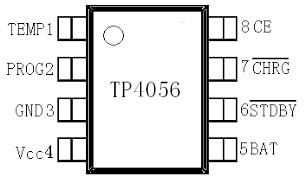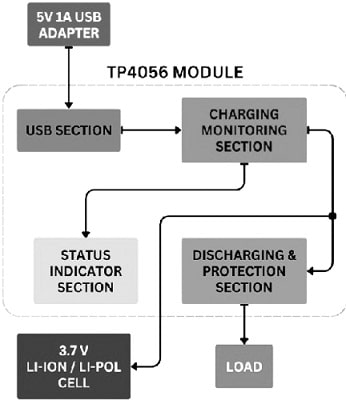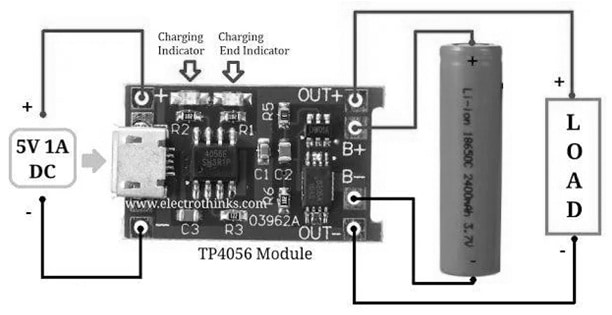Li-ion battery charging integrated circuits play a significant role in charging and managing the process by ensuring secure and very efficient power delivery to the battery. So these integrated circuits are devices that change battery charging current & voltage to use commonly in portable devices like laptops, tablets & cell phones. Many manufacturers provide a wide range of battery charger ICs for rechargeable batteries like LiFePO4, Li-Ion, nickel-based, and lead acid for wireless and wired applications. Generally, these ICs provide many features for safety and battery management like current limiting, on-chip battery pre-conditioning, monitoring and protection, temperature-controlled charging, and telemetry through SMBus (or) I2C interface. So this article provides brief information on TP4056 IC, pinout, specifications & applications.
What is TP4056 IC?
The TP4056 is a constant-current or constant-voltage linear charger, available in the SOP package. So it is designed for single-cell lithium-ion batteries and portable applications due to low external component count. In addition, this regulator IC can work with USB & wall adapters.
This module has internal PMOSFET architecture, so no blocking diode is necessary. Thus, the charge current can be regulated by thermal feedback to restrict the die temperature throughout high power operation (or) high ambient temperature.
The charging voltage can be set at 4.2Volts & the charging current is set externally with a resistor. So whenever the charging current reduces to the 1/10 set value after reaching the absolute float voltage, then this IC will stop the charging cycle automatically.
When the input voltage from the USB or AC adapter is detached, then the TP4056 IC enters automatically into a low current state and decreases the leakage current of the battery to < 2uA. So the TP4056 can also be arranged in shutdown mode once there is a power supply to decrease the current supply to 55uA.
TP4056 IC Pin Configuration:
The pin configuration of TP4056 IC is shown below. This IC includes 8 pins which are discussed below.

TP4056 IC pin Configuration
- Pin-1 (TEMP/Temperature Sense): It is an input temperature sense pin used for detecting the temperature. So this pin is connected directly to the o/p of the NTC Thermistor within a Battery Pack. Thus, you can decide the Battery’s temperature depending on the voltage at this pin.
- Pin-2 (PROG/Constant Charge Current Setting): The charge current toward the battery can be set by connecting a Resistor known as RPROG between this pin & GND. So the charge current can be anyplace which ranges from 130mAmps to 1000Amps depending on the resistor value.
- Pin-3 (GND/Ground): It is a ground pin of IC.
- Pin-4 (VCC/Supply): It is the power supply pin of the IC which supports 8V maximum voltage at VCC however normally 5Volts is used.
- Pin-5 (BAT/Battery Connection Pin): It is the battery connection pin that is connected to the +ve terminal of the battery so the voltage supply at this pin can be 4.2Volts.
- Pin-6 (STDBY/Standby Pin): Whenever the battery is charged completely, then this pin can be pulled low. So an LED is connected to this STDBY pin to specify standby mode.
- Pin-7 (CHRG/Charging Pin): Whenever the battery gets charged, then this pin will be pulled low. So an LED connected to this pin indicates the battery charging condition.
- Pin-8 (CE/Chip Enable): It is an input pin that enables this IC into operation (or) disabling it. So whenever a HIGH input is provided, then TP4056 IC will be in normal mode and when a Low input is provided, then this IC will be disabled.
Features & Specifications:
The features and specifications of TP4056 IC include the following.
- TP4056 IC is a constant-current (or) constant-voltage linear charger.
- IC is available in the SOP package.
- It has battery temperature sensing, under voltage lockout, and automatic recharge.
- It has two LED status pins used for charging & termination.
- This module charges & discharges Li batteries securely
- It is suitable for 18650 cells & other 3.7V batteries
- The charging current is 1Amps.
- Input voltage ranges from 4.5V to 5.5V
- The full charge voltage is 4.2 volts.
- It protects the battery from overcharging & over-discharging.
- The input interface is possible with a mini USB.
- Current: 1A adjustable.
- Charge precision is 1.5%.
- Over-current protection of the battery is 3 Amps
- The Under voltage protection of the battery is 2.5 V.
- The power of this IC is 4.2 watts.
- Charging indicator with micro LED
- Operating temperature ranges from -10 to +85ºC.
Equivalents & Alternatives
Equivalent TP4056 ICs are; TP4056A, TP5100, TP541, MCP73831, MAX1811, etc. So alternative Li-ion battery charging ICs are; TP4057, TP5100, TP5000, MCP73831, LTC4054, MAX1898, MAX1555, BQ24074, MAX8903, RV4056, IP2312, TP541, etc.
TP4056 Li Cell Charger Module Circuit
Lithium-ion (or) Lithium-polymer cells may blow up if shorted, overcharged, and charged or discharged with extreme currents. So, the TP4056 module includes a charger & a protection system used for a single 3.7V Li cell.
This module monitors the voltage level continuously for the Li-Pol or Li-Ioncell in both the charging & discharging phases to supply short circuits and overcharge protection. So it operates with a 5V 1A DC voltage through a USB A to Micro-B cable; normally from an adapter of the smartphone. The low external component count of this module makes it mainly well-suited for convenient electronics applications.

TP4056 IC Block Diagram
TP4056 Li cell charger module circuit is shown below. This module has internally DW01A, FS8205A Dual N-Channel MOSFET, and TP4056A chips. So, this circuit mainly includes four sections USB, charging monitoring, status indicator section, and discharging and protection section. This circuit illustrates the TP4056 module & a 3.7V Li cell main connection for charging & the connection through a load for discharging the charge stored.
Working
The working of all these four sections follows as follows;

TP4056 Li Cell Charger Module Circuit
USB Section:
In this section, a normal female micro USB Type-B port is incorporated into the circuit board to get +5V, 1A power. So this needs a Type-B male micro USB to Type-A male USB cable to attach the module to the adapter of smart phone.
Charging Monitoring Section:
This charging monitoring section checks the Li cell’s voltage level in charging &discharging using TP4056A IC, and at 4.2V it stops charging. So the charge current is firstly set to a default of 1A by the R3 programmable resistor. Further, the output charging current can be modified by changing the suggested resistor value.
Status Indicator Section:
In the charging procedure, the CHRG pin of the IC goes high to turn on the red color LED to specify that the 3.7Volt cell is charging. So whenever the charger charges the lithium cell fully to 4.2Volts, then it lowers the voltage of the CHRG pin automatically and increases the STANDBY pin voltage of the IC thus, it turns ON the blue color LED to specify completion.
Discharging & Protection Section:
The Li cell can be securely discharged through a load and protected through current sensing circuitry. So the DW01A Li cell protection IC protects the 3.7V Li cell from harm (or) degradation occurring by short circuits, overcharge, or over-discharge. Thus, no blocking diode is necessary because of the internal N-MOSFET FS8205A architecture which avoids negative charge current circuits.
If the o/p is shorted, then the current sensing pin of the DW01A IC detects the problem and disconnects the closed lane immediately between the Li cell & the load circuit by simply controlling the FS8205A MOSFET’s gate voltage.
Difference between TP4056 IC and TP5100 IC
The TP4056 and TP5100 ICs are both charging & safety modules that perform precisely in terms of features and power but there are some differences between them. So the main difference between TP4056 IC and TP5100 IC includes the following.
|
TP4056 IC |
TP5100 IC |
| The TP4056 is a single-cell Li-ion battery charger chip that guards the cell from overcharging & undercharging. | The TP5100 is a single Li battery charge management module including an 8.4V/4.2V step-down voltage. |
| It is available within the QFN package. | It is available in the SOP-8 package. |
| Its input voltage ranges from -0.3V to 8V. | This IC works from 5V to 18V. |
| Charge current is 10mA to 1A. | Charge current ranges from 100mA to 2A. |
| Cell type is a single 4.2Volts rechargeable Li battery. | Cell type is dual or single 8.4Volts / 4.2Volts rechargeable Li battery. |
| Its charging accuracy is 1.5%. | Its charging accuracy is 1%. |
| This IC is protected from under-voltage lockout, current monitor, automatic recharge protection, etc. | It is protected from reverse battery, short circuit, temperature protection & shutdown. |
| Its maximum junction temperature is 145℃. | Its maximum junction temperature is 125℃. |
| This IC supports a 4.2V single Li-Cell. | This IC supports both single & double Li-Cell. |
| Soft-Start restricts inrush current. | A soft start is not available. |
| It needs an external Schottky diode. | It doesn’t need an external Schottky diode. |
| This IC is used in mobile Phones, GPS devices, digital cameras, power banks, USB chargers, handheld computers, etc. | This IC is used in portable equipment, various chargers, smartphones, PDAs, mobile cellular telephones, MP4, MP5 players, tablets, HM, power tools, walkie-talkies, etc. |
Advantages & Disadvantages
The advantages of TP4056 IC include the following.
- The TP4056 chip regulates the supplied voltage & current to a battery to ensure the battery is safely & effectively charged or not.
- This IC protects the battery from short circuits, overcurrent, & overcharging.
- It is used in portable applications which are powered by a USB A, a wall adapter, or a Micro-B cable.
- This IC is used to charge different electronic devices like tablets, mobile phones, cameras, power banks, laptops, etc.
- It monitors the voltage range of the battery continuously throughout charging & discharging.
- It has a fixed charge voltage & the charge current can be externally programmed.
- This IC restricts limits inrush currents to guard the battery from short circuits and over currents.
- This IC detaches the charging current automatically to keep away from burn damage if the input voltage is very high.
- It supports lithium-based battery charging like Li-ion & Li-po batteries.
The disadvantages of TP4056 IC include the following.
- It doesn’t contain reverse polarity protection so smoke may result if the battery is incorrectly wired.
- If a load is connected while charging to the battery, then the IC may not notice the fallen charge current. Thus it could charge continuously then this could be unsafe. The TP4056 IC cannot be used as a charger & a load driver together.
Applications
The applications of TP4056 IC include the following.
- TP4056 IC is used in portable electronic devices like tablets, laptops, mobile phones, cameras, power banks, PDAs, charging docks, cradles, GPS, etc.
- It can be utilized to make DIY battery packs.
- This IC can be utilized within battery management systems, solar chargers, mobile phones, digital cameras, GPS devices, USB chargers, handheld computers, power banks, etc.
- It can be utilized to power & charge the battery used for Arduino-grounded systems.
- It can be used as an emergency backup power supply for cell phones & other devices.
Please refer to this link for the TP4056 IC Datasheet.
Thus, this is an overview of TP4056 IC, pinout, features, specifications, circuit, working, pros, cons & its uses. So this is a single-cell Li-ion battery charger chip that protects the cell from overcharging & undercharging. TP4056 IC has number of features like prevention from overcharging, shirt circuit, over discharging, stable voltage, small form factor, current and it works with different power sources. So this is a versatile and reliable chip that can charge single-cell lithium-ion (or) lithium polymer batteries safely & efficiently for different applications. Thus, here is a question for you, what is TP541?